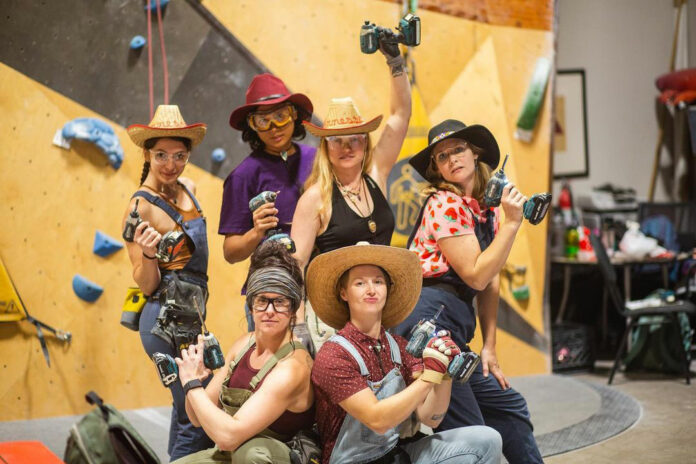Behind the Impact is a series of interviews with head routesetters which examines various topics in the setting industry, with the goal of helping new setters develop their skills and gym operators better understand what goes into a successful setting program. In this segment, Devin Dabney converses with Hayley Moran, Head Setter at The Crag and co-creator of Siege the Southeast, about some of the ingredients that go into supporting a setting team that lasts, as well as the importance of including routesetting exercises in that mix. Got a topic you’d like us to dive into? Submit your ideas here.
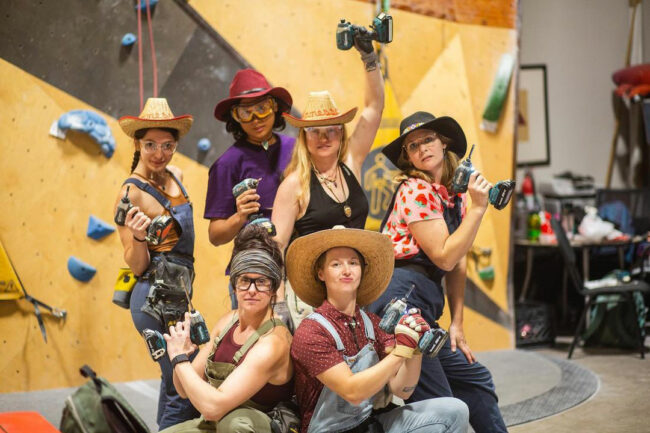
Routesetting is a rewarding job, but it’s not an easy one. It’s a multi-faceted role that’s demanding both physically and mentally, and it requires you to solve problems quickly—both on your own and with a team that’s often comprised of people you don’t know very well. All these factors can make it challenging to build a sustainable setting program—that is, one with a happy, creative, talented team who will stick around for many years. Thankfully, there are leaders in the setting world who acknowledge these challenges and take measures in their programming to inspire, unify and grow their teams.
Hayley Moran is one of those leaders. Though I met her in person for the first time at this year’s CWA Summit, I’ve been following her work for a long time. It’s clear she knows how to engineer a successful team, not only because of what I’ve seen her accomplish (including attaining her L3—congrats Hayley!) but also because of the many setters I know who speak highly of her. Hayley and I had an insightful conversation about some of the key elements she focuses on when building a sustainable setting program, and how setting exercises have helped. Below are three of these elements, as well as some examples of routesetting drills that come from myself, Hayley, and other setters in the industry.
But first, I want to emphasize that this article starts from the assumption that your setting team already has the basic requirements of a good working environment (i.e., fair compensation, a reasonable schedule, and quality working conditions). The suggestions below are meant to supplement these factors, not replace them.
For the purposes of this article, setting exercises are defined broadly as “any activity—be it individual or cooperative—focused on practical or theoretical skills related to routesetting.”
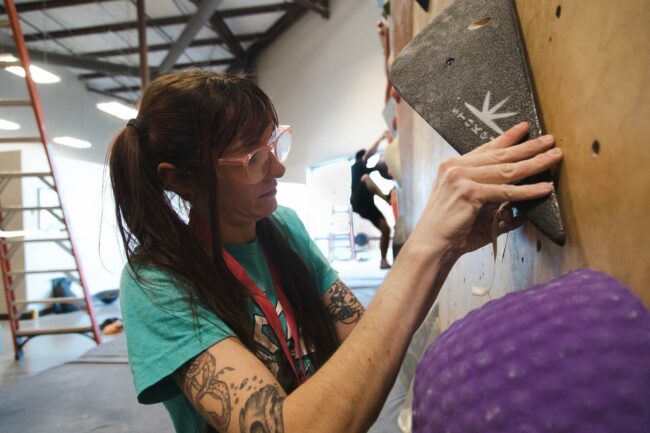
1. Mitigating Burnout
Many commercial routesetters know the feeling of burnout (a reality that Dave Wetmore poignantly details in his Truth Behind the Trade series). It can latch onto us without warning, simply due to the Sisyphean nature of our careers. Having different approaches or routines for your setting day can not only keep things fresh but give you something to focus on when your creativity isn’t coming through. “I try hard to switch up our setting process every few months, so no one gets bored or starts to burn out,” Moran told me.
“There are days when everyone [on my team] shows up and has fruitful ideas and is psyched to set. But there are just as many other days where we’re feeling uninspired or stuck on one idea, or quite frankly just out of ideas that seem exciting,” Moran continued. “To counteract those feelings (and inevitably promote experimentation), I divert my team to a setting exercise (we just call them games) to get everyone out of their heads.”
Moran’s reference to setting exercises as games highlights a key point: they don’t always have to require formality. When I was the only setter at a gym, I once did a ‘Marvel month’ where every climb I set was named after something in the Marvel universe. Often the names hinted at particular qualities in the climb, such as “The Hulk” being a burly cave route or “Ant-Man” being a thin slab on tiny crimps. Moran cited a similar exercise, combining words with movements and then pairing them with a random difficulty. Truly, the only limit is your imagination—well, that and your gym’s company policies of course.
“By making a set feel like a new challenge or game, I keep the setters on my team engaged and allow them to feel free in their creativity,” Moran said. “I try to challenge them to set with different holds or set new moves that I haven’t seen them set before.”
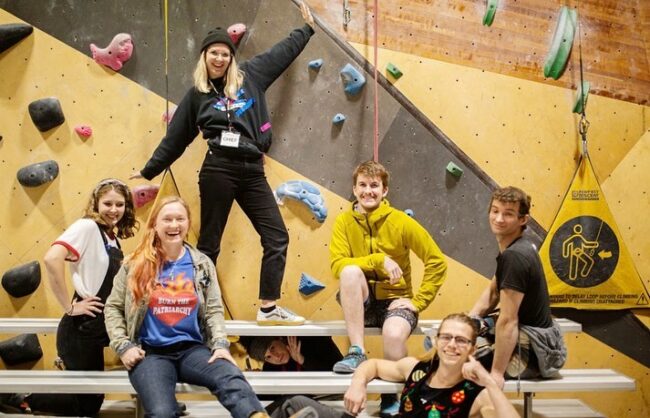
2. Encouraging Team Building
Similar to climbing itself, routesetting is an individual effort that is done as a team, but getting a team of different personalities, interests, and energy types (i.e., introvert vs. extrovert) can be challenging. Setting exercises that require communication and cooperation between teammates can help strengthen professional bonds and help build mutual respect between teammates. Not everyone on the team has to be best friends, but creating space for bonding is important, and is ultimately the responsibility of the head setter. Without intentionally growing together, setters can easily feel isolated—particularly if they are a demographic minority, new to the team, or both. Isolation exacerbates feelings of burnout or job dissatisfaction, making work less comfortable for everyone.
Moran agreed that team cohesion is important to success, though that will look different for each team. For her team, Moran said camaraderie between teammates has been crucial. “Friendship has always been a huge value to me on the teams I’ve worked with,” she said, “and for there to be 100% trust and vulnerability with another setter, I need to feel a deeper connection with them which I would label as having a personal friendship rather than just a co-working relationship. Can a team of non-friends create a product on the wall? Yes. Is that product different depending on the dynamics of a team? Absolutely. For me personally, my best work is produced when I am setting with people who I can laugh with, who I know on a deeper level, and who I can fully trust.” Moran also said her team does a lot of things together outside of work. “I think it’s super important to do things as a team to keep team dynamics cohesive. I think it’s important to eat lunch together, check in on what everyone is doing outside of the gym/climbing, go on outdoor trips together, and watch comps together.”
While I personally love this level of team unity, I know that not every teammate will want to hang out with their coworkers outside of work. Head setters have to find a way to build respect and trust between team members without forcing someone on the team to conform to what the majority wants. Introverts may get drained by too much social interaction, but extroverts may feel isolated without it. This is another instance where setting exercises can be very helpful; they offer a means to connect your setting team in a work context, particularly if the exercises are done in pairs or small groups. In this way, there is communication and connection happening between teammates, but they are also being compensated for their time. Again, the goal is not necessarily friendship—it’s trust and respect—though friendship can be an added bonus.
It’s also worth noting that team bonding can be small, relatively mundane things throughout the setting day, such as asking the team a question at morning debrief or chatting in the hold room while everyone gears up. “We hacky sack as a team after lunch to warm up before forerunning,” Moran told me. “This usually puts everyone in a good mood to start communicating with each other since most of us set without a lot of chit chat.” You can also find middle grounds of connection that aren’t work related; for example, I only encourage more introverted setters to hang out with the team on special occasions (such as celebrating the end of a comp or welcoming a new team member), and I will also hear a more extroverted teammate’s request to get to know their teammates better by organizing hangouts outside of work or inviting the team on climbing trips.
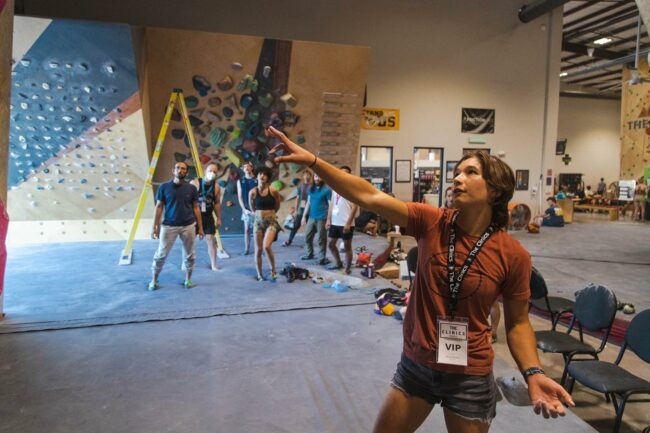
3. Facilitating Professional Development
The third thing that kept coming up for sustainable setting programs was opportunities for bettering skills. While many setters will already have means to seek out clinics, camps, and other ways to improve their craft, intentional space for professional development can also happen at work. Setting exercises are one of the ways that can happen; they can help develop various skills that a great routesetter embodies.
Instead of picking setting exercises at random, target specific ones based on the skills you want your team to improve upon, remember or rethink. Moran had several examples of exercises that do this, including an exercise focused on building athletic empathy. “Once we forerun a boulder [climbing normally], I’ll often ask a setter to run it again and imagine they are a different member, or a first-time climber, or a youth team kid, etc.,” she explained. “I think practicing this often allows us to automatically be empathetic of others and not get as biased in our own abilities…I try to manage our time in a way that allows us to play with improving a set to be its best form, even if it already goes in its current state.”
There are many workplace skills you can focus on when searching for (or creating) routesetting exercises. Here are some examples of valuable traits for routesetters, specifically:
- Communication—knowing how to fully articulate an idea, thought, feeling or opinion to other people
- Time Management—striking a balance between quality and efficiency
- Athletic Empathy—viewing climbs through various lenses of skill, risk commitment and experience level
- Drawing Inspiration—pulling ideas for setting from outside sources, such as other sports or activities
- Versatility—developing competency with different holds, angles, and movement types
- Adaptability—being able to work with sudden, unexpected changes or constraints
- Teamwork—cooperating, communicating, and working well with other people
- Flow—knowing patterns, sequences and expectations—and when to break them
- Distribution Composition—being able to see a set of climbs as a whole, and figure out what it needs
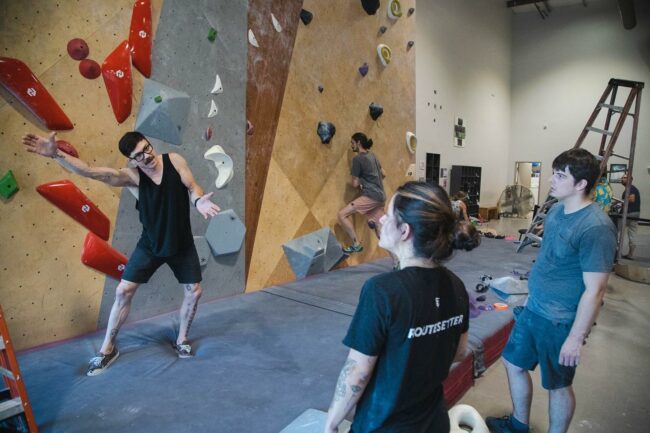
Getting Started with Setting Exercises
If you’re excited about setting exercises, below are some suggestions from Moran, myself, and other routesetters. Moran discusses a few of these in her own article at CWA, which is a good companion read to this piece. Keep in mind, some of these exercises are more time-consuming and should only be done occasionally, while others are simple enough to do regularly. Also, some exercises are best done with boulders, though most of them can easily be adapted to roped climbs.
| EXERCISE | SKILLS | TIME NEEDED | DESCRIPTION |
|---|---|---|---|
| Ask the Audience | athletic empathy, communication, versatility | less | Find a staff member, fellow setter, or even a climber in the gym, and ask them what they'd like to see set. You can also put twists on this too; for example, I ask what style of climbing the person hates the most, then try to set something in that style, but make it so fun that they can't help but try it. |
| The Final Countdown | adaptability, flow, time management | more | Have the setters pick out holds and bolt them all, then start a stopwatch and only give them a short period of time (i.e. 20 seconds) to put each hold on the wall. |
| Five Holds | adaptability, drawing inspiration, teamwork, versatility | more | Give everyone five holds (including hands and feet) and have them set those five holds on the wall, suggesting a particular movement or idea. Once everyone is done, have them rotate to a draft they did not set and finish out that boulder. |
| Robot and Computer | communication, teamwork | more | In pairs, designate one setter as the 'robot' and the other the 'computer'. The two must set a boulder together, but the Robot cannot talk and the Computer cannot move or do the actual setting. Only the Robot can put holds on the wall, and only the Computer can talk. |
| Setting for Character Bios | athletic empathy, distribution composition, drawing inspiration | less | At the beginning of your setting day, hand each setter a bio for a fictional climber. These bios should describe the climber's ability level as well as characteristics, and even a photo if you'd like! Here are some examples: (James) 47-year-old trad dad who doesn't have a belay partner today, so he's forced to boulder; (Stella) 13-year-old strong youth competitor who is really good at crimping, but wants to get better at slopers compression; (Chad) 22-year-old campus bro who climbs V5, but only if it's a dyno. |
| The Ole' Switcheroo | adaptability, drawing inspiration, versatility | less | As the head setter, start the day off with your team as usual and have your team choose and bolt their holds. Once bolting is done, tell them to switch boulders with someone else. Don't let anyone share their ideas or intentions with the holds until after forerunning. You can also have setters pick out an entire set of holds for another setter to use. |
| Switch It Up | adaptability, flow, versatility | more | Try to fit together as many holds and/or movement styles in a single climb as possible, while still creating a cohesive climb that flows well together. |
| Theme Day | adaptability, drawing inspiration | less | Described in the "Mitigating Burnout" section earlier. Select a 'theme'—such as a word, popular franchise, or movie—and build a climb around that idea. You can also have setters draw random themes from a hat. |
| Classic Time Limit | adaptability, time management | less | Simply set a time limit for each climb, then try to finish a skeleton of each climb within that limit. |
| Musical Chairs | adaptability, flow, time management | more | Designate a total time limit to complete a single boulder, then have setters begin working on a climb, but every fifteen minutes have them rotate one direction to work on an adjacent climb. Continue this until the time limit is reached and the boulders are all complete. |
About the Setter
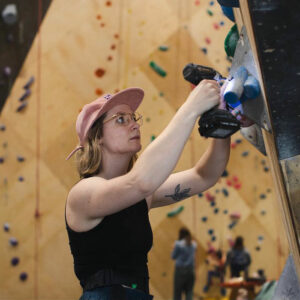 Hayley Moran is the Head Routesetter of The Crag in Nashville, Tennessee. She is an L3-certified USAC setter that has worked numerous competitions and events she’s proud of, including an all-women competition in March 2021 that she hosted. Hayley also worked at Memphis Rox for several years, which is where she initially trained as a routesetter.
Hayley Moran is the Head Routesetter of The Crag in Nashville, Tennessee. She is an L3-certified USAC setter that has worked numerous competitions and events she’s proud of, including an all-women competition in March 2021 that she hosted. Hayley also worked at Memphis Rox for several years, which is where she initially trained as a routesetter.
When she isn’t leading her team or setting for competitions, Hayley spends her time cooking, caring for her cats, and creating collage art.
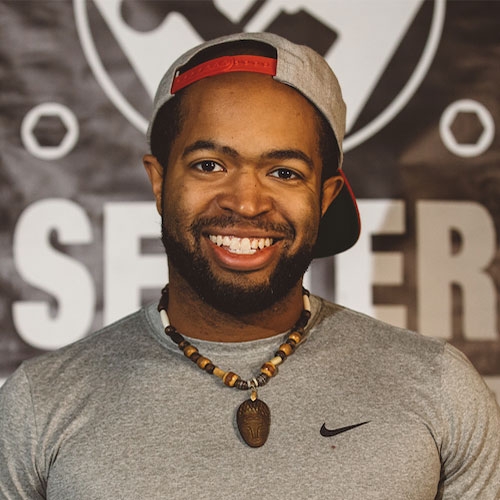
Devin is a professional podcaster, writer and music producer who lives in Indiana. In addition to CBJ, he also writes for The Climbing Zine. Devin has spent over a decade working in the climbing industry in a variety of roles, including head routesetter, competitive youth coach, personal trainer, event coordinator and community ambassador. When he isn’t making music, climbing, drawing or traveling, you can usually find him playing video games or grabbing a beer with his friends.




